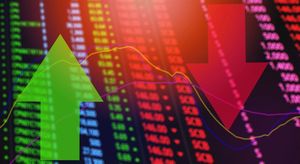
New York, NY – October 16, 2025 – The financial markets witnessed an extraordinary event just last week, on Friday, October 10, 2025, as options trading volume surged to an unprecedented high, clearing over 110 million contracts. This historic milestone, which shattered previous records, was overwhelmingly driven by the robust activity of retail traders, who aggressively "bought the dip" in a volatile market. The record-breaking day highlights the growing and undeniable influence of individual investors, signaling a significant shift in market dynamics and raising questions about future stability and price formation.
This surge in retail-driven options trading occurred concurrently with a sharp downturn in the broader stock market, marking its worst performance since April. Despite the widespread sell-off, sparked by geopolitical concerns, retail investors demonstrated a remarkable resilience and an increased appetite for risk, utilizing highly leveraged options contracts to position themselves for a rebound. This behavior underscores a new paradigm where individual investors are not merely passive participants but active shapers of market sentiment and momentum.
The Day the Options Market Roared: Details of a Historic Session
Friday, October 10, 2025, will be etched in financial history as the day the Options Clearing Corporation (OCC) cleared an astounding 110 million option contracts, surpassing the prior record of 102.6 million set on April 4 of the same year. This monumental volume marked only the second time daily trading volume exceeded the 100 million contract threshold, underscoring the exceptional nature of the day's activity. The driving force behind this surge was unmistakably the retail trading community, whose collective buying power and strategic deployment of capital in bullish call options stood out.
Data from prominent market makers like Citadel Securities revealed that the retail crowd executed its largest total buying spree since January 27, 2021—a period synonymous with the peak of the original "meme-stock mania." A telling statistic from the day showed that individual investors purchased 11% more bullish call options compared to institutional traders, while simultaneously buying 23% fewer bearish put options. This aggressive stance by retail traders was particularly concentrated in broad market indices and exchange-traded funds (ETFs), with the S&P 500 (SPX) and the Invesco QQQ Trust Series I (NASDAQ: QQQ) seeing immense activity. Beyond these broad instruments, options tied to specific companies such as Wolfspeed Inc. (NYSE: WOLF), IREN Ltd. (NASDAQ: IREN), and Applied Digital Corp. (NASDAQ: APLD) were among the most actively traded single-stock names.
The backdrop to this record-breaking options day was a turbulent session for the broader equities market. The S&P 500 experienced a 2.7% decline, its most significant fall since April 10, while the Nasdaq Composite plunged 3.6%, its largest drop since April 4. The Dow Jones Industrial Average (DJIA) shed 878.82 points, or 1.9%, its steepest one-day percentage decline since May 21. This marketwide contraction was largely attributed to a post by President Donald Trump on Truth Social, where he threatened severe tariffs on Chinese goods, among other protectionist measures. Despite, or perhaps because of, this market selloff, retail investors notably chose to double down on their positions rather than retreat, further amplifying the day's options volume.
The events of October 10, 2025, are not isolated but rather represent the culmination of a broader trend of escalating retail participation in the options market. This trend gained significant traction during the COVID-19 pandemic, fueled by factors such as the widespread adoption of zero or low-commission brokerage accounts, a prolonged period of low interest rates, the increase in remote work, and intense media focus on "meme stocks." Options trading volumes have been on a consistent upward trajectory, with 2024 marking the fifth consecutive record-breaking year for Cboe US options volume. A critical development in this timeline is the surging popularity of zero days to expiration (0DTE) options, which by September 2025, for the first time, exceeded 60% of total US stock trading volume, largely driven by retail investor influence, signaling a structural shift in how prices are formed and market volatility is amplified.
Companies Navigating the Retail-Driven Options Wave
The explosion in options trading volume, particularly by retail investors, creates both winners and losers across the financial ecosystem. Brokerage firms, market makers, and specific underlying companies find themselves at the forefront of this evolving landscape.
Potential Winners:
- Brokerage Firms: Platforms like Robinhood Markets, Inc. (NASDAQ: HOOD), Charles Schwab Corporation (NYSE: SCHW), and Interactive Brokers Group, Inc. (NASDAQ: IBKR) are direct beneficiaries of increased trading activity. Higher options volumes translate into more commissions (even if small per trade), increased payment for order flow (PFOF) revenue, and greater engagement on their platforms. The ease of access and low-cost trading offered by these firms have been instrumental in attracting the current wave of retail options traders.
- Market Makers: Firms such as Citadel Securities, Susquehanna International Group (SIG), and Virtu Financial, Inc. (NASDAQ: VIRT) thrive on volatility and high trading volumes. As liquidity providers, they profit from the bid-ask spread on options contracts. The record-breaking day provided ample opportunities for these entities to facilitate trades and capture profits, especially given the increased retail participation which often provides diverse order flow.
- Options Exchanges and Clearing Houses: Organizations like Cboe Global Markets (BATS: CBOE) and the Options Clearing Corporation (OCC) benefit directly from increased volume through transaction fees and clearing fees. Cboe, as a leading derivatives exchange, has actively expanded its offerings of weekly and daily expiring contracts, catering directly to the demand for short-dated options like 0DTEs. The OCC, as the central clearing counterparty, sees its role and revenue grow with every cleared contract.
- Companies with High Retail Interest: Companies whose stocks become popular targets for retail options trading, such as Wolfspeed Inc. (NYSE: WOLF), IREN Ltd. (NASDAQ: IREN), and Applied Digital Corp. (NASDAQ: APLD) on October 10, can experience increased liquidity and potentially more volatile but often upward price movements due to concentrated buying in call options. While this can lead to price dislocations from fundamentals, it can also create opportunities for these companies to raise capital or gain market visibility.
Potential Losers/Those Facing Challenges:
- Institutional Investors and Hedge Funds: While some sophisticated institutions can leverage options for hedging or directional bets, the unpredictable and often momentum-driven nature of retail options trading, particularly with 0DTEs, can create significant challenges. Sudden surges in options volume can distort traditional market signals, make risk management more complex, and lead to unexpected market swings that can erode returns for strategies relying on fundamental analysis or longer-term trends.
- Investors Relying on Traditional Valuation: The increased influence of options trading, particularly from retail, can lead to price discovery that is less tethered to company fundamentals. This can make traditional stock valuation methods less effective and create a more speculative environment, potentially leading to mispricings and increased risk for long-term, value-oriented investors.
- Companies with Low Retail Interest: While not directly losing, companies that do not capture the attention of the retail options trading crowd might find themselves overshadowed or experiencing relatively lower liquidity compared to their more popular counterparts, potentially affecting their cost of capital or market valuation over time.
The record-breaking options day, driven by retail, underscores a market where the interplay between underlying assets and their derivatives is more complex and influential than ever, necessitating adaptation from all market participants.
Wider Significance: A New Market Paradigm
The record-breaking options trading volume, predominantly fueled by retail investors on October 10, 2025, transcends a mere statistical anomaly; it signifies a profound and potentially enduring shift in the structure and dynamics of financial markets. This event is not an isolated incident but rather a dramatic manifestation of broader industry trends that have been gathering momentum over the past few years. The democratization of financial tools, largely facilitated by commission-free trading platforms and easily accessible information, has empowered individual investors to an unprecedented degree, transforming them from peripheral players to significant market movers.
This phenomenon fits squarely into the ongoing trend of increasing retail participation and sophistication. What began with the "meme stock" frenzy of 2021 has evolved, with retail traders now actively engaging in complex derivatives strategies, particularly with highly leveraged zero days to expiration (0DTE) options. The fact that 0DTE options volume exceeded 60% of total US stock trading volume by September 2025 demonstrates a structural change where retail investors are increasingly influencing price formation, often amplifying market volatility. This shift has ripple effects across the entire ecosystem, challenging traditional market participants and potentially altering the efficacy of established investment strategies. Competitors and partners alike must now contend with a market where sudden, retail-driven surges in options activity can rapidly alter asset prices, hedging costs, and overall market sentiment.
From a regulatory standpoint, the escalating retail involvement in high-risk options trading, especially 0DTEs, is likely to attract increased scrutiny. Regulators globally are concerned about investor protection, market stability, and the potential for systemic risk if highly leveraged positions unwind rapidly. Discussions around enhancing disclosure requirements, implementing stricter suitability standards for complex products, or even introducing circuit breakers for options markets could gain traction. The inherent leverage and rapid expiry of 0DTEs mean that even small price movements in the underlying asset can lead to substantial gains or losses, posing significant risks to unsophisticated investors and potentially creating cascading effects across the market.
Historically, periods of heightened speculative activity, often driven by new market participants or technological advancements, have preceded significant market corrections or regulatory interventions. Comparisons can be drawn to the dot-com bubble of the late 1990s or even the speculative fervor in commodities markets during certain eras. While the current environment differs in its specific mechanisms, the underlying theme of widespread participation in high-risk, high-reward instruments echoes these historical precedents. The key difference now is the speed and accessibility of trading, which can accelerate market movements and make interventions more challenging. The current date of October 16, 2025, places this event very recently, suggesting that its full implications are still unfolding.
What Comes Next: Navigating the Evolving Landscape
The record-breaking options trading day on October 10, 2025, driven by retail investors, marks a pivotal moment that will shape the financial markets in both the short and long term. In the immediate future, we can anticipate continued elevated options trading volumes, especially in 0DTE contracts, as retail traders remain emboldened by their perceived influence and the potential for rapid gains. This could lead to sustained periods of increased market volatility, as large options expiries and concentrated retail activity create significant gamma and delta hedging flows from market makers, potentially exacerbating price swings in the underlying assets.
In the long term, the sustained presence and influence of retail options traders will necessitate strategic pivots and adaptations across the financial industry. Brokerage firms will likely continue to innovate, offering more user-friendly interfaces and educational resources, while also potentially facing pressure to enhance risk warnings and suitability assessments for complex products. Market makers will refine their algorithms and risk management strategies to better account for the unique patterns and often less predictable behavior of retail order flow. Traditional asset managers and institutional investors will need to integrate the "retail factor" into their market analyses, understanding that fundamental valuations alone may not always explain short-term price movements.
Market opportunities will emerge for those who can effectively cater to or predict retail sentiment. This could include new financial products designed for shorter-term trading, enhanced data analytics services that track retail activity, or even investment strategies that aim to capitalize on retail-driven momentum. Conversely, significant challenges will persist, particularly for regulators grappling with how to balance market innovation and accessibility with investor protection and systemic risk mitigation. The potential for market dislocations, flash crashes, or concentrated losses among retail investors remains a significant concern, especially if the broader market experiences a more sustained downturn.
Potential scenarios and outcomes include a continued "gamification" of trading, where entertainment value and social media influence play an increasingly significant role in investment decisions. Another scenario could see a regulatory crackdown, potentially curbing the growth of 0DTE options or imposing stricter controls on retail access to highly leveraged products. Alternatively, the market could adapt, with institutions and retail traders finding a new equilibrium where their respective influences are better understood and managed. The key will be how quickly and effectively all stakeholders can adapt to this new, more democratized, and often more volatile, trading environment.
Comprehensive Wrap-Up: A Market Transformed
The events of October 10, 2025, where retail traders drove options trading volume to an all-time high, represent a critical juncture in the evolution of financial markets. The key takeaway is the undeniable and growing power of the individual investor, who, armed with accessible trading platforms and sophisticated instruments, is now a primary force in market dynamics. This shift highlights a departure from a market solely dominated by institutional players, ushering in an era where collective retail action can significantly influence price discovery and volatility, even in the face of broader market downturns.
Moving forward, the market will likely remain highly sensitive to retail sentiment and activity, particularly in the options space. The proliferation of 0DTE options, favored by retail for their leverage and rapid potential returns, suggests that short-term price movements and technical factors may continue to play an outsized role. This environment demands increased vigilance from all market participants, as traditional indicators and analytical models may need recalibration to account for this new layer of market complexity.
The lasting impact of this retail-driven options surge could be a permanently altered market structure, characterized by faster reactions, higher volatility, and a greater need for adaptive risk management strategies. It also puts a spotlight on the role of financial education and responsible trading, as the accessibility of powerful, leveraged instruments comes with commensurate risks.
Investors should closely watch for several key developments in the coming months. Firstly, monitor regulatory responses and potential policy changes concerning retail access to derivatives. Secondly, observe how institutional investors and market makers adapt their strategies to this new retail-influenced landscape. Finally, pay attention to indicators of retail sentiment and options positioning, as these will continue to offer crucial insights into short-term market direction and potential areas of volatility. The record-breaking day for options trading volume is not merely a statistic; it is a clear signal that the financial market has transformed, and all participants must evolve with it.
This content is intended for informational purposes only and is not financial advice






